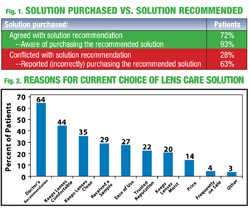Today’s consumer has many options. Just walk into the local retailer and you can find an aisle stocked with different contact lens solutions. It is then up to the consumer to sort through the different prices, product comparisons and similarly designed brand vs. generic boxes. Overwhelmed by the number of options, this is generally the point when the “patient” gets confused and the “consumer” takes over. Consumers begin to compare prices and individual ingredients on each solution box to see if they can uncover the magic code to contact lens care happiness, without sacrificing comfort or risking personal safety.
Knowing this scenario repeats itself everyday in stores around the world, I must ask the question: How do patients rank a doctor’s recommendation for contact lens solutions? Taking this a step further, should doctors go beyond making only a verbal recommendation and start prescribing solutions for individual patients?
Dr. Jason Miller, O.D., M.B.A., and colleagues presented a poster at 2010 American Optometric Association’s conference in Orlando, Fla., illustrating important factors patients consider when purchasing contact lens solutions.1 Prior to examination, 64% of the patients said that a doctor recommendation was the primary reason they purchased a specific solution. Comfort ranked second in selecting a solution (see figure 1 and 2).
During the examination, the eye care practitioner recommended a specific, widely available lens solution to address the patient’s individual lens care needs. A survey was then conducted to track whether the patient followed the recommendation (see figure 1 and 2).1
Seventy-two percent of the patients bought the recommended solution, and 93% of those patients did so knowingly. On the flipside, 28% patients did not buy the recommended solution, of which 63% believed they did follow the doctor’s recommendation.1
 Nearly one-third of the study subjects not buying the recommended solution is a significant number, and I can theorize some reasons—confusion with look-alike generics or the lack of a written reminder while making the purchase—but the main lesson learned is that our patients value our opinion when it comes to contact lens solutions. As you schedule appointments, your fitting fees should not only include the fit of the lens, but also a discussion of the solution. Make sure to address comfort and cleaning, capabilities of the solution and you will have nailed the top three things that patients look for in a solution. This will hopefully prevent a future contact lens dropout and profit loss in your business!
Nearly one-third of the study subjects not buying the recommended solution is a significant number, and I can theorize some reasons—confusion with look-alike generics or the lack of a written reminder while making the purchase—but the main lesson learned is that our patients value our opinion when it comes to contact lens solutions. As you schedule appointments, your fitting fees should not only include the fit of the lens, but also a discussion of the solution. Make sure to address comfort and cleaning, capabilities of the solution and you will have nailed the top three things that patients look for in a solution. This will hopefully prevent a future contact lens dropout and profit loss in your business!
In conclusion, when the patient gets a recommendation directly from you, the doctor, it resonates only good things within your practice. This recommendation builds trust between you and the patient—not only for contact lens care, but also to manage any other eye diseases that may arise in the future. Imagine that just by delivering great patient care with a contact lens solution recommendation, you could enhance the medical model of your practice and be rewarded with good word-of-mouth reviews and potential references. I encourage you to try it!
1. Miller J, Powell S, Espejo L, et al. Solution recommendations for soft contact lens wearers. Poster presented at AOA. June 2010. Orlando Fla.


